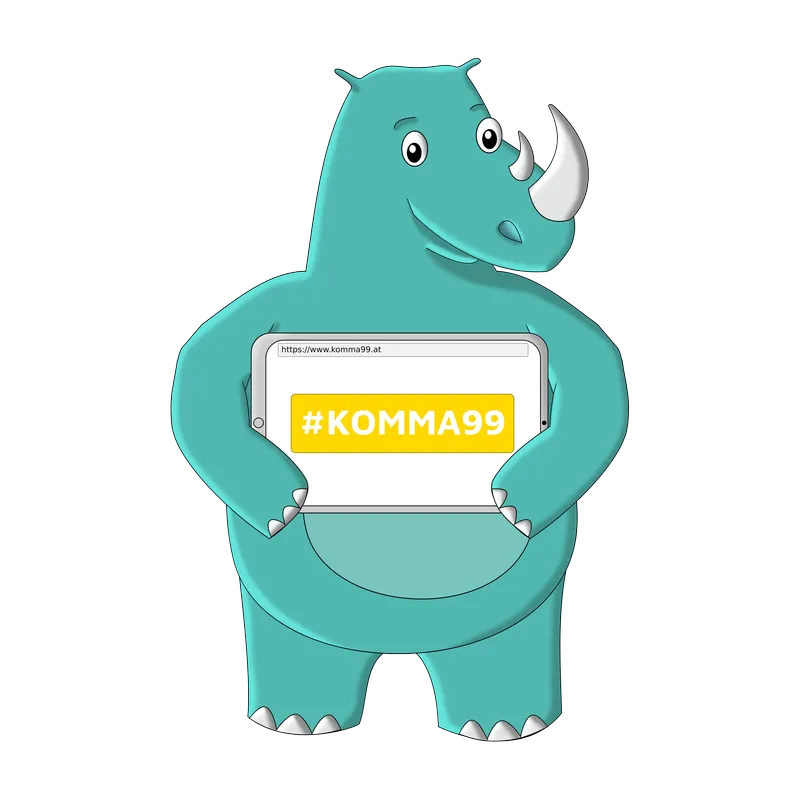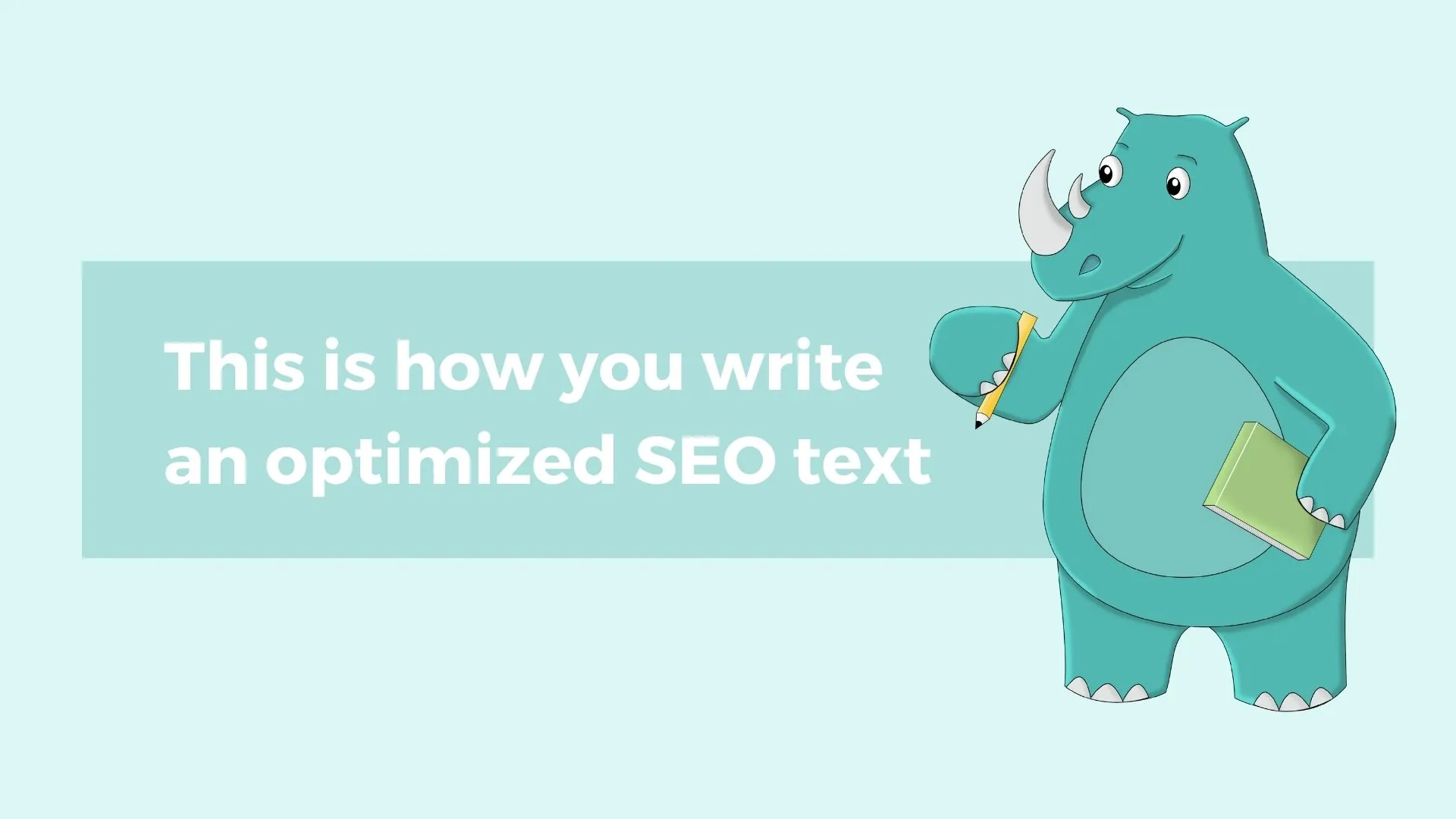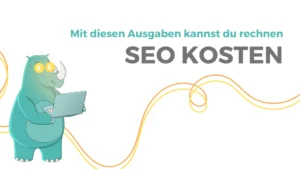Our step by step guide to writing SEO texts including 5 bonus tips
Want to learn how to write SEO copy but don't know where to start? Keywords, WDF*IDF, research and then also maintaining a good text flow - This can understandably be overwhelming. So let’s take a step back and look at SEO copy from the outside – We explain what is really relevant for SEO copy and how to get into the writing flow without despair.
Texting for the search engine (e.g. Google) and at the same time the user is not difficult - but also not easy and needs practice. In the following you will learn what makes a good SEO text, get a step-by-step guide for your first SEO text and 5 tips from our copywriters that will convince you not to give up copywriting.
 |
Don't forget: Every SEO text is unique - you should choose the length and keywords accordingly, adapted to your content and the topic. |
What does it mean to write SEO texts?
Let's start by giving you an understanding of what SEO actually is. Search engine optimization describes various steps that must be implemented in order to make your site relevant for users and search engines (e.g. Google). The optimizations in the course of SEO are divided into 4 pillars: technology, web design, links and content. If you want to know more about SEO in general, please read our blog article - because this is only about one of the pillars: the content, i.e. image, video and text .
A page is only relevant to Google if the content is right on the topic. Not so long ago it was easy to produce content, Google set very vague guidelines on this – keyword stuffing was the order of the day to reach #1. Especially since 2022, but also in the years before that, good content is a must!
If you want to organically achieve a high position in Google, you have to convince the user, and at the same time Google, with content. Highly positioned texts are of very high quality, answer all of the user's questions and also convince the Google search engine with their abundance of keywords, length and search volume. Of course, your SEO text should also be able to do this!
Why SEO texts are relevant?
As already mentioned, search engine optimization consists of 4 pillars - technology, web design, links and content. All four pillars are essential to achieve a good ranking. A new page is technically optimized and the web design is also in place - these factors can be actively covered, but need to be optimized from time to time. Link building is very complex and only has a very slow effect on the ranking in search engines such as Google.
SEO texts, on the other hand, can enrich your website again and again in the form of blog articles and new service pages and achieve successive organic and sustainable rankings. The combination with technology, web design and links is of course still essential.
You see - well-written and high-quality SEO copy can quickly propel your site and increase visibility.
Structure of a SEO text
We now know what SEO texts are and that they are quite relevant for the ranking of your website or online shop. But how is an SEO text actually structured and what does it all include?
▸Keyword
At the beginning of every optimized text is the keyword. In our Glossary article you can read more about keywords and in another blog article more about Keyword mapping. This means that before we even start writing it, it is essential to do a broad keyword research, then to structure these keywords in a mapping and only then to create the content.
▸Title & Meta-Description
Another important part of a good SEO text is a suitable SERP snippet. This refers to the snippet that appears on the search results page and is intended to motivate the user to click on your page. In order to optimize the SERP snippet perfectly, we have created a tool: Our in-house SERP snippet generator - Give it a try!
▸H tags
What also characterizes an SEO text is a clear H-Tag structure. This means sorting the headings by value. H1, H2, H3, H4, … – This is how the user knows your text and the eye can orientate itself better. The H-Tags are also very important for the Google search engine, because it also has to orientate itself in your text in order to be able to classify the relevance.
▸The optimized text
The last piece of the puzzle for the optimal SEO text is – who would have thought it – the text itself. Well structured, with a red thread running through it and full of elegantly built-in keywords, this is how an SEO text should be and only in this way does it make the user and the search engine happy at the same time.
Your step by step guide to quality content
Now you're ready to start writing your own SEO text on your chosen topic. You know why optimized text is so relevant and you also know what it needs to contain. Now it's a matter of writing this text in order to achieve happy users and a higher ranking as soon as possible.
Here's our ultimate step-by-step guide to doing so:
1. The research
With our keyword research and mapping in hand, we can get started. As an example for the step-by-step guide, we take the keyword “SEO” to hand. Through our Keyword Research Tool we see that the keyword is searched 3300 times a month in Austria – the search volume is relatively high, which means that a ranking would be optimal, but cannot be achieved that easily.


Then you start typing the main keyword itself into the search engine to get a general idea of what it is turning up. This method tells you quickly and easily what your competitors had to include in the text in order to be positioned at the top of the search results page. You will also get an insight into the most important questions about the keyword.
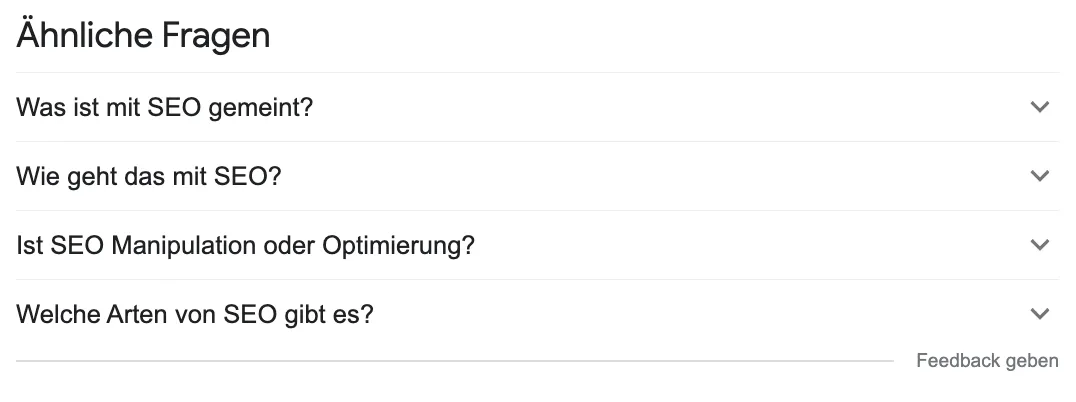
 |
Caution: Google does not automatically display the most frequently asked questions for all keywords. |
The first 10 search results and the "similar questions" generated by Google give you a good basis for your texts. Of course, such research is not everything - your own know-how and knowledge from books and articles can help also be installed here. But a look at the search results page at least gives you the direction in which your SEO text has to go in order to be successful for users and the search engine Google.
 |
Tip: Don't copy and don't trust blindly. Your competitors can also make mistakes and incorrect or copied information can have a negative impact on your ranking. |
In this first step, empathize with your user - age, interests, etc. - all of this plays a role and determines whether your SEO text ranks well or not. Tools like Ahrefs and reading in forums help you to fully understand your user and thus create better content. We also have a for the buyers persona and the customer journey Blog article ready.
2. The structure
With a large mountain of research and a lot of information, you should now get down to the structure. Here we mean the title and meta description and the h tags that we told you about earlier.
For both points we have examples for you here:
Title and meta-description
You should also orientate yourself on your competitors when it comes to the title and meta description. What do the other websites write about your keyword? Do you prefer blog articles or web shops? Pay close attention to what you want the keyword to target, and most importantly, make sure the SERP snippet appeals to the user.
Ask yourself the question: Which sentence would I click on?
To illustrate the relevance of optimized title and meta description we give you a bad and a good example for our keyword "SEO":
X No 
⩗ YES 
Which SERP snippet would you be more likely to click on?
Of course, to the second, because:
+ Good structure
+ Eyecatcher with icons
+ Short & concise
+ No fake info
+ Keeps what it promises
Don'ts for your SERP snippet:
- Clickbaiting
- Too long sentences
- Uninspired content
- Repeating text
- Keyword Stuffing
With our in-house SERP-Snippet Generator you can easily check whether your snippet is too long and whether the keyword occurs - at the same time you can make it an eye-catcher with symbols.
 |
Remember: The SERP snippet is the gateway to your site, so decorate it accordingly and be welcoming! |
H-Tags
Before you start writing, we recommend that you create a structure for the headings. This way you will always know your way around, don't lose the common thread and, above all, cover all areas that are relevant to SEO .
Here you can let your creativity run free - What would you be interested in about the topic? What is the competition doing? And what questions are asked most frequently on the topic? Combine your research with your feeling for the target group.
For example, a good H-tag structure for our keyword "SEO" may look like this:
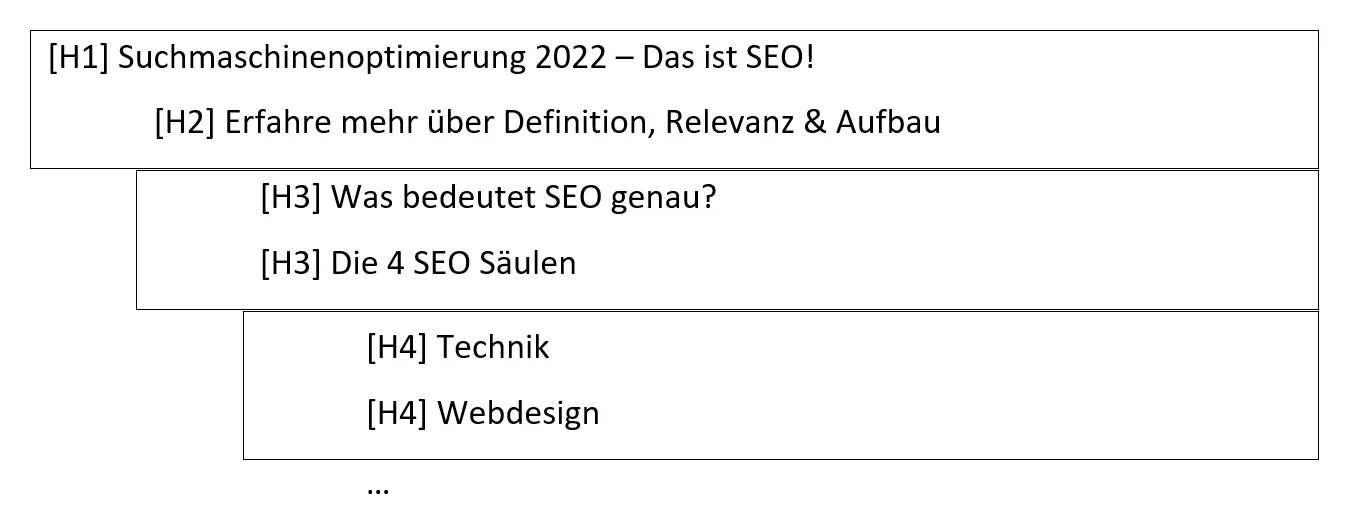
Let yourself be inspired here and build a good basis for the further SEO text - This will make it easier for you to write the next step!
3. The text
You are armed with research after research and a structured basis for your text - Now there is nothing stopping you and you can start writing your text. Each company has its own style and of course its own target group.
So our biggest tip for copywriting is: find your style and write away.
You can follow these guidelines:
- Get your readers' attention right from the start. Include a question, answer it, and promise more further down the text. If we're being honest, it's very rare that users actually read the whole text - but by starting in an exciting way, you keep more users on the site!
- Make your content simple but professional. You and your readers won't do any good if they have to googling every other word first. Feel like your readership, write precise and meaningful sentences and explain foreign words that relate to your industry.
- Address your readers personally! This also holds the attention and brings a certain flow to the SEO text. Depending on your target group, it is best to use the direct address in a “you” or “you” form.
- Loosen up your text where possible. Either way, it's difficult to keep the reader's attention until the end. With anchors for the eye, you create variety and a stimulus to keep reading. Paragraphs, images, graphics, lists, lots of white space - this is how a text is read easily and happily.
- Use your keyword in the right measure. It should appear more often at the beginning of your text, as well as at the end. Your keyword is also well placed in the headlines for an optimized SEO text – just don’t overdo it. Keyword stuffing pleases neither Google nor your reader and is always unsuccessful!
Stick to these guidelines and write with a lot of know-how and research. Write in such a way that you enjoy reading your own text - then you've made it.
4. The optimization
What distinguishes an SEO text from a "normal" text is the extensive research at the beginning and the keyword focus that runs through the entire text. The wonderful WDF is used to skilfully accommodate keywords in your SEO text *IDF Tool by Seobility. You enter your keyword and with one click all relevant competitors and all relevant keywords are displayed.

Here you will find a rough guide to the minimum length of your text.
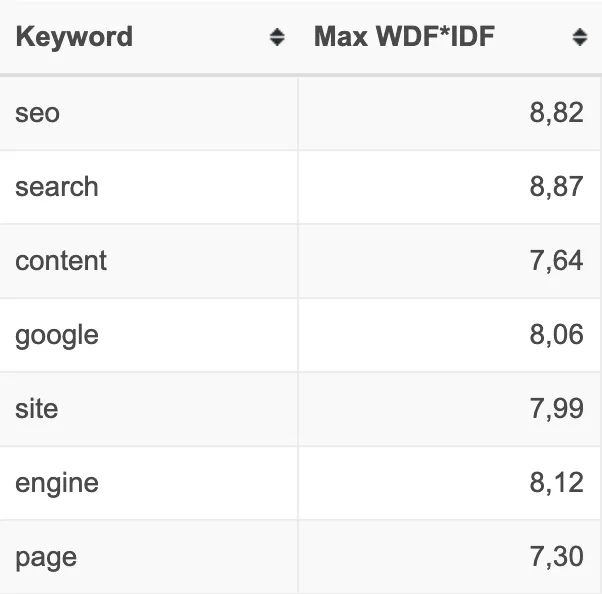
A tabulated view of the keywords to be included....
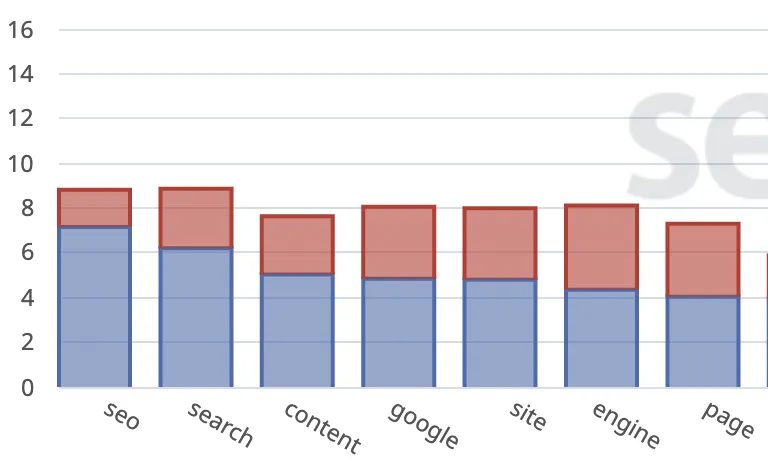
...with an additional graphical view.
So you always have an eye on which additional keywords you should include in your text. We recommend writing first before using the tool, so you don't let it influence you too much and your text doesn't lose quality.
With the WDF*IDF analysis you optimize your text quickly and easily and cover a variety of keywords skillfully without the text being immediately recognized as "SEO text".
 |
Tip: The tool isn't perfect - sometimes it spits out keywords that just don't make sense. Therefore, do not blindly rely on it and always use your common sense! |
5. The quality assurance
The text is ready - from an optimal basis, to the structure, to the writing, we have now covered all the necessary points. But one of the most important steps is still missing - the correction! Do not publish your text before four eyes have read it.
For fine-tuning, we also have a few guidelines so that you don't forget anything:
- Every word must be relevant - Filler words or even unimportant passages should be left out, regardless of whether the word count suffers as a result, because quality is more important.
- Short nested sentences or split them straight into two separate sentences. In this way, your reader does not have to make too much effort and stays mentally with your text for longer.
- Mark certain words or sentences in bold - this way you get even more structure in the SEO text. Also, highlighting helps the reader not lose the line.
- Avoid negations, filler words or passive sentences - as I said, your readers shouldn't bother with the text and read it with a positive feeling, then you've made it!
- Pay attention to spelling and grammar. This is probably obvious to you, but all too often small mistakes are overlooked that make the maximum difference to the reader and reduce your credibility. We warned you 😉
Our 5 tips for optimized SEO texts
You now know everything about the theory of writing SEO texts - now comes the practice. This is the only way you will be able to learn from what you have just read and write optimized texts - the proof of the pudding is in the eating!
Don't you dare to write SEO texts yet? Then we have 5 motivating tips from our SEO copywriters that will make your start easier:
Tip #1 - Just start writing
Easier said than done, but writing right away after doing your research can work wonders. You probably won't be happy with every sentence, maybe even none at all, but you wrote something and your thoughts became words - that always feels good!
If you don't like your text from the start, leave it for a night. We assure you that on the one hand you will like it much more and on the other hand, after a good night's sleep, you will come up with even better formulations - try it.
Tip #2 - Write first, then optimize
WDF*IDF and the keyword focus are important factors for successful SEO texts in search engines like Google - but not the only ones. Before you start writing, feel free to do some research on relevant keywords, keep them in mind, but don't write for them.
Only when you have written your text should you add the necessary keywords or leave them out, depending on how your text allows it. This way you are guaranteed to write high-quality SEO texts with a common thread instead of stringed sentences full of keywords.
Tip #3 - Quality assurance is the first and last
We can't mention it enough - but quality assurance is essential! Get a second person to keep an eye on your text, use a spelling program, do everything possible to make sure your text is published error-free.
By having clean copy that people can follow, you'll strengthen your audience's trust in your brand more than you might initially think.
Tip #4 - No Fake News
A little research, some information and write a text from it? You should be careful, especially with topics that may not belong to your area of expertise! Just like the spelling and grammar, the information should also be clean and truthful - because incorrect information will also lose the trust of your potential customers.
Tip #5 - Structure, structure, structure
Actually, this tip applies to any text you can think of, but specifically for SEO texts, the structure simply has to be right. As we have already mentioned, H-tags and a table of contents are very helpful for the user and the search engine Google - but especially for you!
With a clear and logical structure, you can always put your text aside, do more research and you will never lose the thread. Define the structure at the very beginning - it can still change at any time, that's up to you.
Conclusion about SEO texts
SEO texts are many things - structured, full of information, target group-oriented, exciting and definitely not easy to write. With our step-by-step guide and the tips it contains, you have created a good basis for to write your first SEO texts. Try it out and get inspired - and if you realize that copywriting just isn't your thing, then there's still Online marketing agencies that can help you.
Good luck and have fun with your writing!


